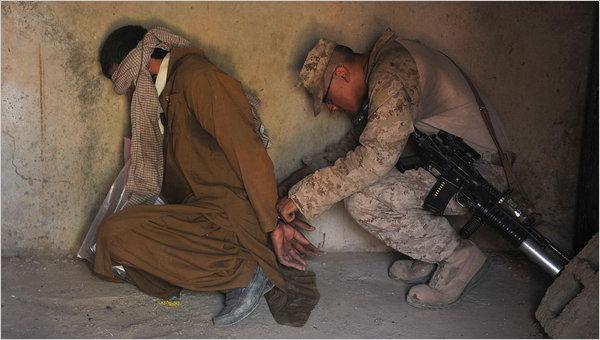It is such a simple photograph, and yet strangely evocative. If you think about it, this photo may be one answer to the question that hangs over the war in Afghanistan. That question is, what are we seeing, really?
One man handcuffs another. They are different men: enemies, one shackling the other; one in uniform and combat boots and the other in ordinary clothing and civilian shoes; one blindfolded and the other wearing glasses and looking intently; one a prisoner and the other heavily armed.
And yet they are the same man: each in the same crouch, head forward, hands exposed, the same coiled intensity, neatly spaced as if in formation on the same ground before the same wall. The gun, a piece of equipment projecting backwards, is balanced by the scarf, now an instrument of detention, in the front. If they were kids, they could be playing leapfrog. If they were allies, they could take turns helping one another, covering each other’s back. But they are enemies–if not before the man was detained, surely so by now. Or perhaps not completely so, as the attitude of the Marine need not be hostile: just doing his job, right? One might wonder if there is any symmetry in the political situation to correspond to the parallel poses in this picture.
Here we are seeing double, which may be the only way to see straight on the borderlands of the American empire. One man has been pulled into a war not of his own making–but which one? One man has become a prisoner of war–but which one? One man’s country is being ruined by war, ideology, and corruption–but which one?
The US military occupation of Afghanistan continues with no favorable resolution in sight. The reportage, such as the story alongside this photograph, has all the marks of another imperial morass. The mission is succeeding and conditions are improving, but everything being accomplished can only be sustained by continued occupation and enormous expenditures that either ignore or exacerbate the structural problems.
In the midst of all this, to see straight, you may have to see double. To see not only what is different, but also what is the same; to see not only the costs on one side, but also the costs on the other side; to see not only the future, but also how much it resembles the past; to see not only the successes but also how entire societies can become habituated to failure; to see not only progress but endless war, waste, and loss.
Photograph by Massoud Hossaini/Agence France-Presse–Getty Images.
Cross-posted at BAGnewsNotes.

Discussion